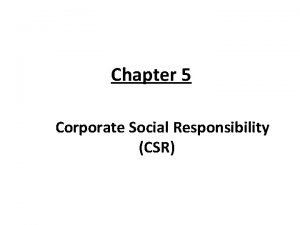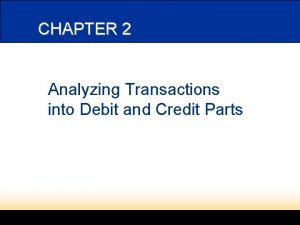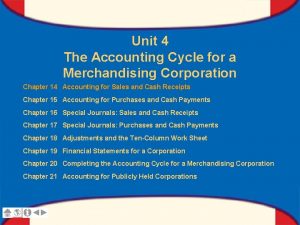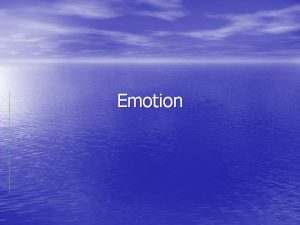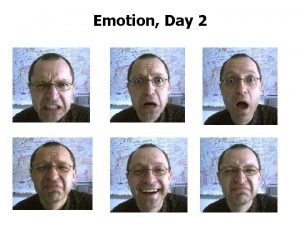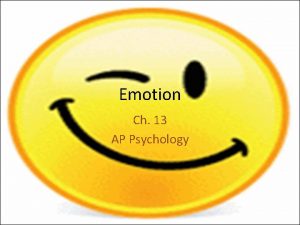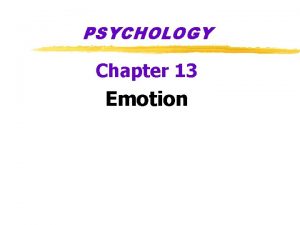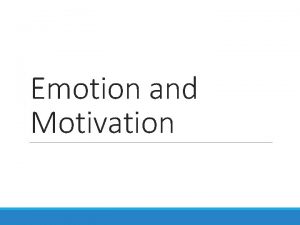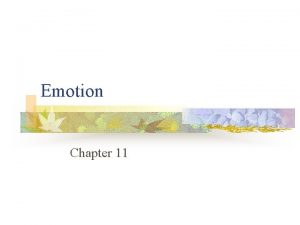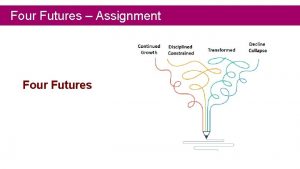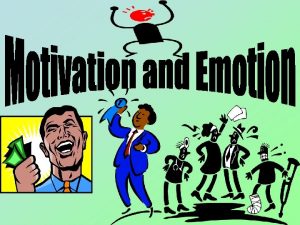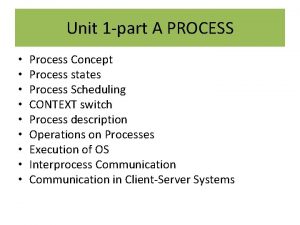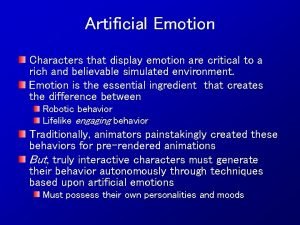Emotion Emotion Emotion A four part process that























- Slides: 23

Emotion

Emotion �Emotion – A four part process that involves physiological arousal, subjective feelings, cognitive interpretation, and behavioral expression – all of which interact, rather than occurring in a linear sequence. �Helps organisms deal with important events.

Evolution and Emotion �Emotions have evolved to help us respond to important situation and to convey our intentions to others.

Evolution and Emotion �Example � Sexual jealousy probably has an evolutionary basis because mate infidelity threatens the individual’s chances of producing offspring.

Cultural Universals in Emotional Expression �Most emotions, but not all, are universally understood regardless of culture. �Facial expressions are used to convey universal messages and motions.

Cultural Universals in Emotional Expression �Display Rules – The permissible ways of displaying emotions in a particular society.

Counting the Emotions �How many emotions are there? �Probably over 500, but 7 are universally recognized. � Anger � Disgust � Fear � Happiness � Sadness � Contempt � Surprise

The Purpose of Emotions �Emotions are normally meant to help us adapt to our environment and signal others how we are feeling. � But, if too intense or prolonged, they may become destructive and detrimental to our mental health.

Emotional Differences b/t Men and Women �Biology �Culture �Gender Stereotypes �Differences in Punishment and Reinforcement

Where Do Emotions Come From? �Unconscious Emotions: �The Limbic System � Fight or Flight – Attack, Defense, Retreat �The Reticular Formation � Responsible for emotional reactions such as fear and anger in emergency situations. � Early warning system. � Communicates with Amygdala and Thalamus to help arouse the brain in emergencies.

Where Do Emotions Come From? �Conscious Emotions �The Cerebral Cortex � Interprets events and associates them with memories and feelings to create emotions. � Lateralization of Emotion – The different influences of the two brain hemispheres on various emotions. � Left Hemisphere influences positive emotions. � Right Hemisphere influences negative emotions.

Where Do Emotions Come From? �Autonomic Nervous System �Plays the key role in emotionally arousing your internal organs (like your heart) in different situations.

Where do Emotions Come From? �Sympathetic Division of Nervous System – Helps us respond to unpleasant stimuli. �Parasympathetic Division of the Nervous System – Helps us respond to pleasant stimuli.

Where Do Emotions Come From? �The Role of Hormones �Serotonin – Depression �Epinephrine – Fear �Norepinephrine – Anger �Steroids – Change the way nerve cells that release hormones are excited. � Why people on steroids become angry easier… Roid Rage.

Psychological Theories of Emotion �James – Lange Theory �The proposal that an emotion provoking stimulus produces a physical response that, in turn, produces and emotion.

Psychological Theories of Emotion �Cannon-Bard Theory �The counter-proposal that an emotional feeling and an internal physiological response occur at the same time: One is not the cause of the other. �Both were believed to be the result of cognitive appraisal of the situation.

Psychological Theories of Emotion �Schachter’s Two Factor Theory �The proposal claiming that emotion results from the cognitive appraisal of both physical arousal (Factor 1) and an emotion provoking stimulus (Factor 2).

Psychological Theories of Emotion �Cognitive Appraisal Theory �Theory of emotion which theorizes that individuals decide on an appropriate emotion following the event. � Make a conscious decision about how we should feel after the event has occurred.

Psychological Theories of Emotion �Opponent-Process Theory �Theory of emotion which Theorizes that emotions have pairs. �When one is triggered, the other is suppressed. � Example emotion. – When we feel happy, sad is the suppressed

Emotion and Athletic Performance �Inverted U Function – Describes the relationship between arousal and performance. �Both high and low levels of arousal produce lower performance than does a moderate level of arousal. �Sensation seekers – Individuals who have a biological need for higher levels of stimulation than do other people.

How Much Control do We Have Over Our Emotions? �Although emotional responses are not always consciously regulated, we can learn to control them.

How Much Control do We Have Over Our Emotions? �Emotional Intelligence – The ability to understand control emotional responses. �Helps significantly in having the ability to properly control our emotions.

How Much Control do We Have Over Our Emotions? �Detecting Deceptions �Lie Detectors (Polygraphs) used to detect deceptions to determine if people are lying. � Can be inaccurate and have many flaws. � Physiological signs are not always telling of whether or not people are lying, which is why they’re often inaccurate. � Polygraphs are really just arousal detectors.
 Phân độ lown ngoại tâm thu
Phân độ lown ngoại tâm thu Block av độ 1
Block av độ 1 Thơ thất ngôn tứ tuyệt đường luật
Thơ thất ngôn tứ tuyệt đường luật Thơ thất ngôn tứ tuyệt đường luật
Thơ thất ngôn tứ tuyệt đường luật Chiến lược kinh doanh quốc tế của walmart
Chiến lược kinh doanh quốc tế của walmart Tìm vết của mặt phẳng
Tìm vết của mặt phẳng Con hãy đưa tay khi thấy người vấp ngã
Con hãy đưa tay khi thấy người vấp ngã Tôn thất thuyết là ai
Tôn thất thuyết là ai Gây tê cơ vuông thắt lưng
Gây tê cơ vuông thắt lưng Sau thất bại ở hồ điển triệt
Sau thất bại ở hồ điển triệt 4 corners shape
4 corners shape Four eyes skin assessment tool
Four eyes skin assessment tool Four part processing model for word recognition
Four part processing model for word recognition Four part processing model for word recognition
Four part processing model for word recognition Example of legal responsibility
Example of legal responsibility Part two analyzing transactions into debit and credit parts
Part two analyzing transactions into debit and credit parts Problem 14-1 recording merchandising transactions answers
Problem 14-1 recording merchandising transactions answers Part whole model subtraction
Part whole model subtraction Unit ratio definition
Unit ratio definition Part part whole
Part part whole Define technical description
Define technical description This is the centerpiece of any pouring station
This is the centerpiece of any pouring station The part of a shadow surrounding the darkest part
The part of a shadow surrounding the darkest part Part to part variation
Part to part variation














